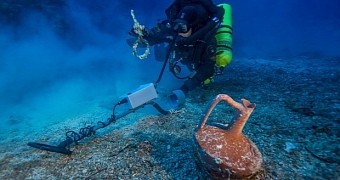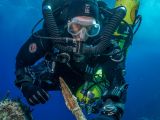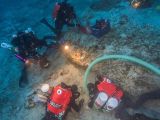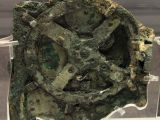Back in 1900, sponge divers exploring the waters off the coast of Greece's Antikythera island in the Aegean Sea came across the remains of a ship that sunk sometime around 65 BC.
At the time, the sponge fishermen recovered dozens of statues and sculptures, pieces of jewelry, glassware and furniture, and even skeletal remains of crew and passengers from among the vessel's remains.
They also found the famous Antikythera mechanism, i.e. the world's first computer, a device likely designed and put together by Greek scientists, and that served to track the movement of planets and stars in the sky.
Although there was plenty left to plunder, the divers gave up on searching for hidden treasures at the site of this ancient shipwreck after two of them were paralyzed and another died in an accident.
Fast forward well over a century and, last year, the Woods Hole Oceanographic Institution, together with researchers at Greece's Ephorate of Underwater Antiquities, set out to have a closer look at the shipwreck.
As it turns out, it was a most inspired decision
Last year, between September 15 to October 7, scientists used an autonomous underwater vehicle to explore the site of the shipwreck and create a 3-D map revealing its exact location on the sea floor.
Underwater archaeologists dove to inspect the sunken vessel and returned to the surface with stunning artifacts such as lead anchors and tableware. They also found a bronze spear measuring about 2 meters (6.5 feet) in length and believed to have once been part of a statue depicting a warrior.
The research team returned to the site earlier this year, between August 26 and September 16. The expedition proved quite successful, with dozens of other artifacts being recovered from the shipwreck.
Among these treasures are luxury ceramics, a pawn from an ancient board game, fragments of a bone flute, glassware and a bronze armrest that researchers think comes from a long-lost throne.
The team also found parts of the ship itself such as fragments of lead hull sheathing and two lead anchor stocks, the Woods Hole Oceanographic Institution and their collaborators detail in a report.
All the same, it looks like there are plenty other treasures left buried at this site in the Aegean Sea. Thus, a metal detection survey revealed that metallic objects that are yet to be discovered are scattered over a 40 x 50 meter (about 130 x 165 foot) area around the ship's remains.
“This shipwreck is far from exhausted,” marine archaeologist Brendan Foley said in an interview. “Every single dive on it delivers fabulous findings,” the researcher went on to add.
The ship is known as the “Titanic of the ancient world”
This millennia-old shipwreck off the coast of Greece's Antikythera island sits at a depth of roughly 55 meters (approximately 180 feet), underwater explorers say.
Judging by its cargo and its location, researchers think the vessel, undoubtedly a luxurious one, sunk while carrying treasures from the coast of Asia Minor west to Rome. All things considered, odds are it was lost during a storm that sent it smashing against some cliffs.
When in one piece, the vessel measured 50 meters (164 feet) from one end to the other. These days, its remains are scattered over about 300 square meters (3,230 square feet).
Being as big as it is, not to mention loaded with treasures, the vessel is thought of as a Titanic of sorts, albeit one that sailed the world's oceans and was lost to history many centuries ago.
“The evidence shows that this is the largest ancient shipwreck ever discovered. It's the Titanic of the ancient world,” researcher Brendan Foley said in an interview.

 14 DAY TRIAL //
14 DAY TRIAL // 




